A lead extraction is the removal of one or more leads from inside the heart. Leads that are placed outside the heart during open heart surgery cannot be removed during this procedure.
Why do I need a lead extraction?
Your doctor has determined that your lead or leads need to be removed for one or more of the following reasons:
- Damage to the inside (called a fracture) or outside of the lead
- Large amounts of scar tissue forming at the tip of the lead. This causes the lead to need more energy to function than the device (pacemaker or ICD) is able to deliver. This condition is known as “exit block.”
- An infection at the site of the device and/or lead
- Blockage of the vein by a clot or scar tissue
Normal Lead
Lead in Place
Lead with Fracture
How is lead extraction performed?
There are two approaches to lead extraction:
Subclavian Approach
The subclavian approach is the most frequently used approach. The leads are extracted through an incision in the upper chest over the subclavian vein.
Femoral Approach
The femoral approach is used when the subclavian approach is not possible. The leads are removed through a small puncture in the groin over the femoral vein.
Removal of the lead
A special sheath (tube) is placed in the vein. This sheath is threaded over the lead and guided to the tip of the lead (where the lead attaches to the heart).
A laser light or mechanical drill-like tip can often be attached to the sheath to help break up the scar tissue.
The lead is then removed.
Before the Procedure
You will receive an instruction sheet that describes how to prepare for the procedure. Here’s an overview of those instructions.
What time will the procedure take place?
Your health care team will instruct you on the time of your procedure.
Should I take my medications?
Your doctor may ask you to stop taking certain medications a few days before your procedure (such as blood thinners and aspirin). Do not stop taking any medication before checking with your doctor.
If you must take medications before the procedure, swallow them with only small sips of water.
Can I eat?
Do not eat or drink anything after midnight the night before your procedure.
What happens before the procedure?
The procedure will take place in a special surgical room. Before you enter, a nurse will help you get ready. You will put on a hospital gown. You may give your clothing to your family or keep in a locker.
You will lie on a bed, and the nurse will start an intravenous (IV) line. This line allows the doctors and nurses to give you fluids and medications during the procedure. You will receive an antibiotic through your IV to help prevent or treat infections.
You may also have an arterial pressure line placed in an artery in your wrist or groin, and an IV will likely be placed in a vein in your groin. This access can be used to:
- Insert a pacemaker wire to keep your heart in rhythm when your pacemaker is removed;
- Insert tools used to remove the leads;
- Give you fluids, if needed;
- or for all of the above reasons if other veins are too small.
The doctor will decide before your procedure if access to your groin is needed and will discuss this with you.
If groin access is needed, the area will be cleaned, draped and numbed. A needle will be inserted in the vein in the same way an IV is started in your arm, only using a larger needle.
Once the line is in place, a catheter used to pace your heart will be inserted into the vein and guided to the right side of your heart. This is done only if your pacemaker/ICD is being replaced during the procedure. If you are receiving a new pacing device at another time, the temporary pacemaker wires may be placed in your neck.
All catheters and temporary pacing equipment are usually removed at the end of the procedure, and the areas are covered with a dressing.
During the Procedure
To prevent infection or the spread of any existing infection, it is very important to keep the surgical areas sterile. Your chest and both sides of your groin will be shaved and cleansed with a special soap. Sterile drapes will cover you from your neck to your feet. As a reminder to keep your hands from coming into contact with the sterile drapes, soft restraints will be placed around your wrists, limiting the movement of your hands.
Will I be asleep?
You will likely be given general anesthesia, which will cause you to “sleep” through the procedure. General anesthesia can require the use of breathing tube.
If you are not given general anesthesia, you will receive medication through your IV that will make you drowsy throughout the procedure. An anesthesiologist will be present during the entire procedure. If you are uncomfortable when you wake up, please tell the anesthesiologist.
You may feel a pulling as the leads are removed, but you should not feel pain. Your doctor and nurse will be with you throughout the procedure. If you are uncomfortable or need anything during the procedure, let your nurse know.
Several devices will be used to monitor your condition throughout the procedure.
Monitoring During the Procedure
Will new leads be implanted?
New leads may be placed in your heart (implanted) during this procedure or at a later date. When your leads are replaced depends on the reason the leads are being removed. If they are being removed because you have an infection, you will be treated for the infection before new leads are implanted. If you have any questions or concerns about why your leads are being removed or when they will be replaced, please ask your doctor.
Information About Fluoroscopic (X-ray)-Guided Procedures
During the lead extraction procedure, your doctor will use a fluoroscopy machine to see the leads as they are being removed.
Fluoroscopy uses ionizing radiation (X-rays) to create a constant, moving picture throughout the procedure to help guide small instruments through the blood vessels.
The X-ray beam is typically focused on a relatively small patch of skin. This area of skin receives a higher dose of radiation than any other part of the body. Depending on the X-ray dose you receive, you may receive instructions about how to care for your skin after the procedure.
Although it is rare to have any skin reaction at all after a fluoroscopic procedure, you may experience a mild to moderate skin reaction (sunburn effect) on the skin that received the greatest exposure. In extremely rare cases and at very high doses of radiation, hair loss and skin damage are possible. The skin reaction may take several days or weeks to develop.
Before the procedure, please tell your doctor or nurse if you have ever had a fluoroscopy procedure, and whether you had any skin reaction after the procedure.
If you have any questions or concerns about fluoroscopy, please discuss them with your doctor during your preprocedure evaluation.
After the Procedure
How long will I stay in the hospital?
The lead extraction procedure takes 2 to 6 hours to complete. Afterwards, you will be transferred to a hospital room as an inpatient. You will stay in the hospital 2 to 10 days.
If your leads were removed through your groin (femoral approach), you will need to lay flat in bed for several hours after the procedure.
If your new device and leads are implanted at the time your old leads are removed, you may be able to go home the morning after the extraction procedure.
If your device and leads are not replaced at the time of the extraction, you may be hospitalized until they are implanted.Your doctor will be able to tell you how long you should expect to be in the hospital and when your new device and leads will be implanted.
While in the hospital, you will be placed on a telemetry monitor. This small box has wires that connect to your chest with sticky electrode patches. The telemetry monitor allows the nurses to observe your heart rate and rhythm on several monitors. Overnight, they will record this information and have your doctor review it in the morning.
You may have stitches (sutures) that will be removed 10 to 14 days after your procedure. Please ask your doctor about this.
If your leads were removed because of infection, you will likely receive antibiotics after the procedure, either by mouth or through an IV. These antibiotics may need to be continued at home, in which case a home healthcare nurse can help. Please talk to your doctor about any questions or concerns you have.
The morning after the extraction, you will have a chest X-ray to check your lungs and the position of any new leads that were implanted.
Are there risks to having a lead extraction?
A lead extraction is generally a very safe procedure. However, as with any invasive procedure, there are risks. Your doctor will discuss these risks with you, and special precautions are taken to decrease these risks.
Although results and risks vary from patient to patient, over the last 10 years, the overall success rate for lead extraction at Cleveland Clinic is greater than 99.5%. The risk of internal bleeding, tear in a vein or heart, or death is less than 0.5%.


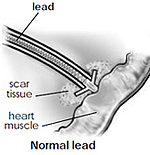
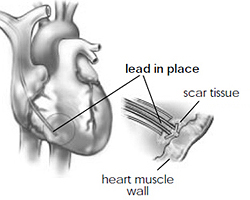
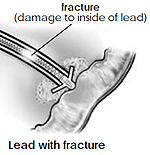

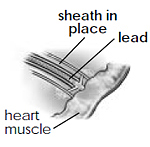
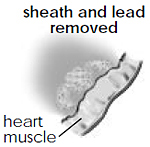

0Comments